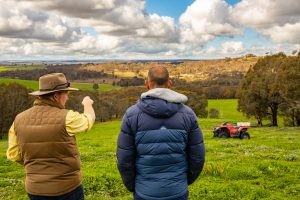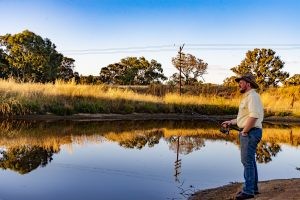George Southwell, Ray White Rural Canberra and Yass
I recently sat down with Dr. Nicola Powell, Allhomes Chief of Research and Economics, to ask her about how our region performed, compared to the rest of Australia during the June quarter and what she expects for the months ahead in terms of buyer demand and house prices.
Nicola is one of Australia’s leading property market experts and has more than 15 years’ research experience that spans the academic, government and private sector. She has a deep understanding of the Australian property market and has focused on property and demographic trends for nearly 10 years. So it was handy to be able to shoot the breeze with her on our shared fascination with property prices and trends.
She’s the leading force behind Domain’s regular data reports that keep the Australian public up to date on what’s happening in the market. You’ll probably recognise her from her many appearances on television and in the media.

George Southwell: Righto Nicola, you’re the brains behind the numbers in real estate in Australia. Everyone knows the market is on fire, but where is it specifically really heating up?
Dr Nicola Powell: Well, George, our most recent house price report really was quite eye-watering in terms of the outcomes. There were three top line outcomes in the June quarter. Firstly, Sydney house prices grew by almost $1,200 a day in the three months to the end of June; the fastest rate of growth in Sydney house prices on record. Secondly, we’ve now got three capital cities with a median house price above a million dollars. Melbourne and Canberra joined Sydney in the June quarter. Thirdly, we’ve got every single capital city posting above 10% growth on an annual basis for houses. It’s the first time that we’ve seen this across all of our cities since the post GFC rebound.
George Southwell: Talking about Canberra and the surrounding region, what did you see there?
Dr Nicola Powell: House prices soared over $1,000 a day over the June quarter. It’s the steepest acceleration that Canberra has seen in three decades. Canberra now has three regions with a median house price above a million, and overall, the city’s median is above a million dollars. So, it’s really been record-breaking in all fronts for Canberra. Unit prices, again, have been much more restrained.

George Southwell: How has Canberra performed during the pandemic?
Dr Nicola Powell: If you look at price movements and increases since the pandemic hit, Canberra is the standout performer. March 2020 is a good measure of when the pandemic hit Australia, because not only is it when we had 100 Covid cases in Australia, it’s also when stage two restrictions started to roll out nationally at the end of March. Since the pandemic, we’ve seen Sydney and Melbourne growth cycles very much interrupted by COVID. We saw housing demand being hampered by extended border restrictions and the economic impacts. But what we’ve seen since the pandemic hit is an extraordinary resilience in prices. Canberra is the one that is the standout performer. It’s seen the greatest increase in price since the pandemic, both for houses and for units.
George Southwell: Why is that?
Dr Nicola Powell: Canberra has a higher average income compared to our other cities, and is also above the national average, it’s got a larger public sector employment base, it has the lifestyle, it’s seen a turnaround in internal migration, and it has lower unemployment rates. There’s lots of reasons why people are moving and why that market has seen such a significant upward swing. But I have to say Sydney isn’t far behind this rate of growth.
George Southwell: What does that mean in terms of the Canberra market and its price cycles over the next few months?

Dr Nicola Powell: It’s a good idea to monitor the movements in Sydney and Melbourne as a barometer. We’re seeing Sydney experiencing much higher rates of growth compared to Melbourne. What it indicates is that Melbourne is behind in terms of its price cycles, and Sydney is much further along. So it could suggest where prices are going to go in Melbourne in terms of the duration and the rate of price growth. But when it comes to smaller cities, like Canberra, they are all now showing very much a strong upward momentum in terms of their price cycle. You can see that across Brisbane, Adelaide, Perth, and particularly Canberra.
George Southwell: What about the trends across Australia?
Dr Nicola Powell: Nationally on our combined capital city basis, we’ve got a record high house price at $956,000. We had a six percent growth over that June quarter, which is one of the steepest growths in a single portion on record, and it would only take another quarter of growth at that rate to crack a million dollars for our combined capital city house price. That’s such a milestone for our major cities. Units are now above the mid 2017 peak, so they’re just over $600,000. They’ve not only recovered all of the nine percent drop that was recorded over that 2017 to early 2019 downturn, they’ve recouped that two percent drop as well as a result of COVID.
There’s a number of factors driving this growth. We’ve still got ultra low interest rates, and we know that free-flowing and falling interest rates (remember, we’ve had three interest rate cuts in the last year) is one of the biggest drivers of demand on our house price cycles. We’ve had lots of government stimulus and an improving economy, but we’ve also spent more time in our homes. When you look at Google mobility data, which is kind of a new data set that’s been released, it shows how long we’ve been spending in our homes over 2020 and into this year. That really has shifted by priorities. We’re seeing that come out of all of our data sets in terms of where people are searching, what they are looking for, where has been the strongest price growth.
George Southwell: Why are there so many buyers in the market right now?
Dr Nicola Powell: We’ve placed such a great emphasis on our homes this year plus we’ve got a high level of household savings, so Australians are really diverting that to paying down debt, and ultimately that’s providing them greater borrowing power. We’ve had the return of expats, particularly from cities that have high house prices in Australia, so I think there’ll be some that deem some of our house prices across our cities to be more affordable. We’ve had low listing volumes at a time where demand this year has just been quite frankly unbelievable in terms of when you look at the number of sales that we’ve seen in the market. As a result, we’ve got new record high house prices across every single capital city, apart from Darwin and Perth.
George Southwell: Houses and units are not experiencing the same price growth. Why is that?
Dr Nicola Powell: Look, there is a huge difference. This is the price gap between purchasing a unit and then purchasing a house across our cities. It is at a record price gap across these particular cities. Our cities are shifting, and we’ve seen a shift from medium to high density dwellings in the inner city, to low density living in our outer edges or outer suburban locations across our capital cities. The way I like to look at this and the way that demographers talk about this is that our capital cities historically over the last 150 plus years have been very much like an egg. It’s a fried egg. The yolk has been the CBD and it’s where the hipsters are, it was the only place you could get a good coffee, and it was where the wine bars were, and then you had the egg white, which was suburbia, where you live with the 2.4 children.

But post COVID world, we’ve seen that change. Our suburbs have become activated. It’s where people are living, it’s where people are working, and it’s where we play. It’s almost like the city has become a place where we go to occasionally. It’s become almost a scrambled egg, and planners have described the scrambled egg for a while. It’s called the 20 minute city. It’s been around for about 20 years. But I think what COVID has done is it’s given our outer suburbs a new lease of life. They have absolutely been activated, and we’ve seen that in demand.
George Southwell: Certainly, in the towns and cities we sell in, we’re seeing far greater demand for houses and rural properties than units…
Dr Nicola Powell: Since the pandemic, we’ve seen demand for houses grow faster than units, we’ve seen house prices increase four times the rate of units on that national basis. In 2021, for every single unit that was sold, 2.8 houses were transacted. That’s much higher than the five-year average. For the five-year average, for every one unit that was sold, there were 2.5 houses transacted. Now, that might not seem a big jump, but it is when you look over that historical change in terms of the dynamics of the transacting of houses versus units. This trend is unanimous across our cities. We’ve got houses well outperforming units, we’ve got a record price gap.
George Southwell: So, why is this happening?
Dr Nicola Powell: I think buyers are definitely willing to pay a premium for space. When you aggregate the data by price point by bedroom, we’re seeing greater rates of growth for more bedrooms, so three bedroom, four bedroom houses have seen a much more rapid increase in price compared to one and two bedroom or two bedroom houses and compared to units. We’ve seen lower levels of investor participation, and investors tend to prefer units.
George Southwell: Nicola, we sell a lot of homes and rural property in the towns near Canberra, in the Capital Region. What is your data telling you about regional property?
Dr Nicola Powell: For our regional markets, we’re still seeing areas experiencing exceptional rates of growth. For example, the Byron LGA increased by 51% year on year, which is just a phenomenal rate of growth. We’re seeing our lifestyle, coastal regions and those hinterland locations or those locations that are close to major cities are still experiencing a high level of interest.
Last year, we saw all areas, including inland regional areas showing strong housing market conditions. These were areas that really work in the commutable belt to a capital city, but all of these areas offered affordability, low population density, and a rural lifestyle. Many of these areas prior to this had had an extended period of decline, either due to drought or mining conditions. But I think those areas that are going to continue to perform well will be those areas that have that lifestyle factor, that have employment opportunities, or connected to a major working hub.
George Southwell: The ability to work remotely is certainly helping our sellers out here.
Dr Nicola Powell: Yes, we’ve seen remote and flexible working arrangements really change and open up where we can reside. We’ve seen an increase in demand for those lifestyle orientated areas and those holiday homes. I think people have been buying those secondary homes, but also affordability. When you have a look, some of our regional areas are half the price compared to their respective capital city. But we’ve still got double digit annual growth, and particularly substantial rates of growth in regional New South Wales, Victoria, and Tasmania. We’re overall seeing the strongest rates of growth since 2003 and 2004.

George Southwell: Do you expect more people to opt into a tree-change, or is the trend plateauing?
Dr Nicola Powell: Over the March quarter, we saw the net loss of over 11,000 people moving out of our capital cities into those regional areas. It’s the biggest loss on record since 2001. What that suggests is that the exodus from the cities, which began at the start of the pandemic, could continue. We’re seeing that the ongoing lockdowns have shifted the value of city life, and we’ve seen the impact on our dwelling prices. What that suggests is part of this change is going to be permanent, because people are actually purchasing their homes. They’re not moving just into rental accommodation in these regional areas, they are moving permanently.
The net loss out of our cities was almost 45,000 people over the last 12 months since the start of the pandemic, and put that into context, that’s up from 24,000 compared to the year prior. So, that’s almost double.
George Southwell: Could this be a permanent change to the population in Australia? Could we be less centralised, away from cities.
Dr Nicola Powell: Well, the big question is, do I think it’s going to revert? I’m not 100% convinced that we are going to see all of this revert. I do think part of it will revert. I think that regional Australia for some is providing a better quality of life. I think if you pose the question, what do you think millennials are going to think about this? What millennials have thought is they’ve worked out that there’s a better model. They’ve worked out that they’ve proven that the workable model by the pandemic in terms of working from home, keeping your city job, and moving to a regional area is possible. I do think there has been a bit of a trajectory shift amongst particularly the millennial cohort.
George Southwell: And who is doing the tree-changing? Is it retirees?

Dr Nicola Powell: When you have a look at the age bracket, and this is really important to understand, the types of homes they’re buying, who’s actually leaving the city, it’s the people in their prime of their working years who are the biggest group moving away from our cities. The exodus from the city to the regions has been led by millennials, then it’s by gen X, and then it’s by baby boomers. I think COVID has probably fast tracked some of their retirement plans.
In terms of the net gain into regional markets, it has been that 45 to 64 year old cohort. But the 25 to 44 year old cohort isn’t far behind that in terms of the net gain. The latest data shows for regional Australia that younger Australians are starting to return to the cities. I think that’s probably due to education and lifestyle. That’s 15 to 24 year olds that are moving to the city. We’re starting to see that the 25-45 year old age bracket trend downwards.
But the older age groups continue to head bush. Anybody aged over 45, the 45 year old age brackets, they are trending higher. There is a net gain into regional Australia.
George Southwell: We’re seeing very successful results in our auctions, even when they’re run online, and many homes are getting offers early and selling prior. Is that happening elsewhere?

Dr Nicola Powell: I think real estate professionals, buyers and sellers have become more accustomed to transacting homes online. We’ve almost seen the virtual option become part of the process of selling, even outside of lockdown periods. We’re seeing those virtual auctions being run out alongside the onsite auction outside of a lockdown period. But also, during those lockdown periods, we’re seeing an increase in virtual inspections. So, I don’t think that buyers are phased anymore by purchasing in a virtual environment, because we’re becoming more accustomed to this way of transacting property.
George Southwell: We’re in this strange time right now. On the verge of spring, our peak selling season, but in a lockdown which means sellers are sitting on their hands; understandably. Spring usually signifies a blast of new listings. Will we see that this year?
Dr Nicola Powell: We know during lockdowns that it does have an impact on supply. We see listings drop, I think buyers and sellers step back from their decisions. You can see that when you compare 2020 to what we’ve seen this year. What we know is that decisions don’t change. They are delayed. It really illustrates the circuit breaker lockdowns that we see in the market. We have seen those circuit breaker lockdowns have a short, sharp impact on the new listings coming to market, and Melbourne has really been a good test case of that. But what we do see is the rebound in listings is quick after those sharp lockdowns. I think what’s interesting about what we’re seeing currently in Sydney, is that we’ve seen a bit of a stabilisation. We saw that initial sharp drop in new listings. We’re starting to see it stabilise week on week in terms of those listings coming to the market.
George Southwell: What do you expect to happen to regional markets, like ours, this spring?
Dr Nicola Powell: We have seen greater housing demand in regional Australia. We’ve seen an increase in rents and prices, and we’ve seen really low vacancy rates.
The next part of this is the job equation. Since the ABS started measuring job vacancies, which was 1979, we’ve seen a huge spike in job vacancies over the last 12 months. There’s just over 360,000 currently in the market. The other side to this is the number of employed people per vacancy is at the lowest level ever. It’s currently at 1.9. Before the pandemic, to put it into context, it was 3.1. Now, this is due to stimulus, increasing demand, but also closed international borders. What that means is businesses are finding it hard to find staff. Based on the number of vacancies divided by the total number of employed people, the employment rate should be sitting at around three percent. It’s not. It’s not anywhere near that. It’s well above that. It’s closer to five percent. But this is unlikely. It’s unlikely to see the unemployment rate hit three percent, particularly given the current outbreaks. But what the RBA has forecast is that the unemployment rate could hit 4.5% by December of 2022.
What all of this data suggests is that we’ve got a strong rebound in the jobs market, and it’s likely that we’re going to hit this target much sooner than the RBA anticipated. What the outcome will be is that we are likely to see wages start to rise sooner and faster than was initially expected, and so will inflation. What we’ve got at the moment is the RBA is expecting interest rate rises to be late in 2024. But what this data suggests is that we could see interest rates move higher before then.








